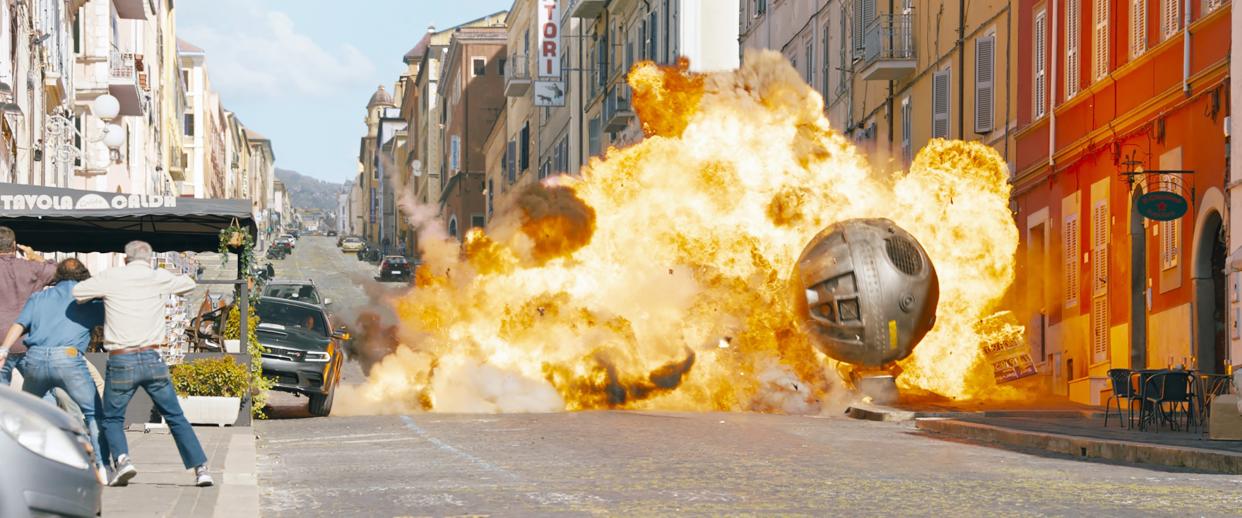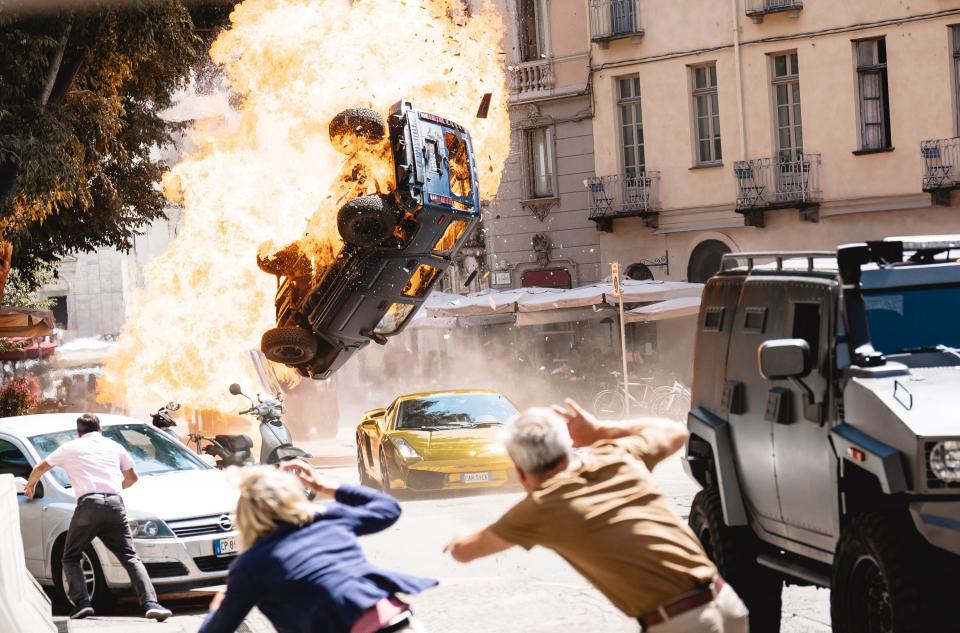How ‘Fast X’ Rolled a Bomb Through the Streets of Rome

Fans of the “Fast and the Furious” franchise have grown accustomed to the series’ increasingly elaborate and outrageous set pieces. Given that “F9” climaxed with a scene in which characters literally drove a car into outer space, the pressure was on for “Fast X” director Louis Leterrier and screenwriters Dan Mazeau, Justin Lin, and Zach Dean to open their film with one of the best action sequences yet. The solution: A thrilling chase through the streets of Rome as bad guy Dante (Jason Momoa) sets loose a 10-ton bomb, and Dom Toretto (Vin Diesel) and his team try to maneuver it away from the crowded city. The sequence consists of 554 shots, nearly all of which are a sophisticated combination of stunt driving, practical effects, and computer-generated imagery that are seamlessly blended into perhaps the most spectacular “Fast and Furious” sequence yet.
The process of designing the set piece began with the location scout, as Leterrier chose streets in Rome and Turin that would allow him to realize his ambitions. “The practicality of shooting overseas in Rome presents problems,” visual effects supervisor Peter Chiang said. “There’s the delicacy of the architecture and the issue of locking whole streets off for two or three days. As you can imagine, the best streets are the closest to the center of Rome.” Once they secured the necessary permissions from the Italian government, Chiang worked with second unit stunt coordinator Andy Gill and special effects supervisor Alistair Williams to determine what the stunt drivers could do, what effects could be done practically, and which ones would have to be created digitally. “My job is coordinating all of the departments to deliver Louis’ vision of what the sequence should be,” Chiang said. “It’s down to the minutiae: What types of cameras, whether I need a helicopter to shoot plates, what we’re going scan in terms of the Rome streets, shooting array plates for blue screen because only a few actors went to Rome — the rest were in cars against blue screen in London.”
More from IndieWire
Julia Fox Says Her Next Movie Is a Nepo Baby 'Spring Breakers'
'The Pot-au-Feu' Review: Food Is Love for Juliette Binoche in This Period Amuse-Bouche
Because Letterier wanted to shoot as much of the action practically as possible, the first step was creating an actual bomb that could roll down the streets while figuring out how much would need augmenting with visual effects. “I started to do some animation tests and quickly determined that although the bomb would be useful as a lighting reference and to give everyone an eyeline, the actual movement of the bomb would have to be more sophisticated,” Chiang said. “It would need to bounce on all its individual edges and hit surfaces and spin, and we could never get that physically.” Of equal concern was the fact that the crew had to work within very specific parameters. “We had to leave the location as though no one had been there, so if you look at all the destruction and the trail the bomb leaves on the streets of Rome, damaging the cobblestone, that all had to be visual effects.” Therefore, Chiang and his team scanned all of the streets for moments when the bomb would have to be recreated in post-production.

Still, the bomb itself was largely shot practically, with a 2-ton steel model coated in perspex and fiberglass according to production designer Jan Roelfs’ specifications. “When I did the animation tests, I wanted the bomb to be 10 tons,” Chiang said. “That lends itself to a particular type of movement and speed, but there was no way that special effects could make a 10-ton bomb move down a street in Italy with all of this fragile architecture and be controllable.”
Obviously, even 2 tons is heavy enough to create difficulties, so Williams and Gill sat down to figure out a way of controlling the bomb. “We put an axle through the big steel ball, and that axle had wires going up to two overhead cables — one going forward, one going back,” Gill said. “And we used a big winch that is designed to tow gliders up into the air with a huge wheel on it, a lot of horsepower. In our testing we were able to get it up to about 35 miles an hour and start and stop it anywhere we wanted. Knowing that we had control, we were able to put the ball in places that we thought weren’t going to be possible. But now that we controlled it, we could drive cars around it, we could jump it, we could do anything we wanted to.”
Williams also figured out how to light the bomb on fire, which Chiang found to be helpful even for scenes in which a CG bomb replaced the reference bomb shot on location. “That was great for us, because if the bomb wasn’t spinning but it was moving at the right speed and on fire, we could take the fire off of it and add it onto the CG bomb, and then I wouldn’t have to create CG fire,” Chiang said. Several of Gill’s driving stunts were similar hybrids of practical capture and digital wizardry, though he was able to execute a surprising number of stunts practically with careful planning, including flipping a car into the air with a cannon in the middle of one of those fragile streets. “You put a big steel post inside a car and fire it and it blows the car up into the air,” Gill said. “I know from experience that asphalt, concrete and everything else can’t take the impact without making a big hole in the road, so in order to get them to let us do it I suggested we put a steel trench plate down where we were going to hit the cannon.”

In addition to the cars, Dante and Letty (Michelle Rodriguez) drive motorcycles in the scene, which created additional complications for Gill — especially since one of the stunts, a 360-degree nose wheelie, was envisioned in a manner never before put on film. Gill’s assistant found a video on YouTube of a rider from Finland who could pull off the stunt, and the final footage of Letty careening through the streets was a combination of that stunt driver and two others. For Gill, finding stunt people close in size to the actors remains essential even in an age of CG slimming. “That’s a lot of time and a lot of money, so I try the best I can to find the right body style and face,” he said. In the case of Momoa, the actor was an expert motorcycle rider who did virtually all of his own driving. “He was a godsend, and he did exactly what we asked him to do — no more and no less.”
In order to seamlessly integrate the stunt driving shot in Italy with the blue screen footage of the actors shot in London, Chiang shot the visual effects plates first. “That’s because we knew we could control the lighting of the actors more so than the lighting of the environment,” he said. “For every street that we shot, we always took 360-degree environment spheres of what the action was with a 12-camera rig. Whenever we had a car driving down the middle of a Rome street, we would physically film it, then we would take that car out. The stunt driver that drove it would then get into what we call an array vehicle, which had these 12 cameras, and physically drive down that same street as a take. So therefore, at any time, Louis Leterrier could cut into a shot of the car and see Vin Diesel driving in an environment exactly as though he was driving down the same street.”
The complexity and scale of the production and the vagaries of shooting on location in Rome created additional challenges for Gill, as the schedule would sometimes shift and require that cars be shot out of continuity in various stages of destruction. This required his team to be smart about which side of the car could be photographed and led to some clever solutions that offer another example of the blend of practical work and CG that characterize the sequence. “For bullet holes, we would just create stickers and put them on the car, and then those would become CG bullet holes later,” Gill said. “Or on the windshield, we would take a really thin sheet of Lexan that’s cracked or has bullet holes in it and just take it on and pull it off. If you walked up to it you would think it was cracked, you couldn’t tell the difference.” For Gill, working on the “Fast” movies is always as great a pleasure as it is a challenge. “You don’t get to create an action sequence like this very often,” he said. “It’s expensive and it’s time-consuming. The beauty of the ‘Fast’ series is that you get to play with the big toys and implement all the great ideas you’ve always wanted to try.”
Best of IndieWire
Where to Watch This Week's New Movies, from 'Fast X' to 'Master Gardener'
Every Palme d'Or Winner from the Cannes Film Festival, Ranked
Sign up for Indiewire's Newsletter. For the latest news, follow us on Facebook, Twitter, and Instagram.

 Yahoo News
Yahoo News 
